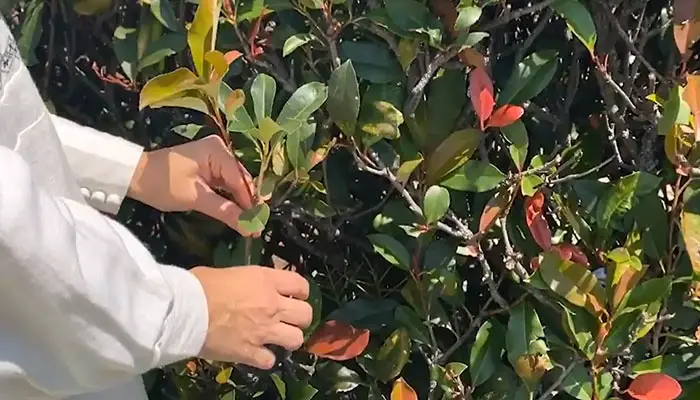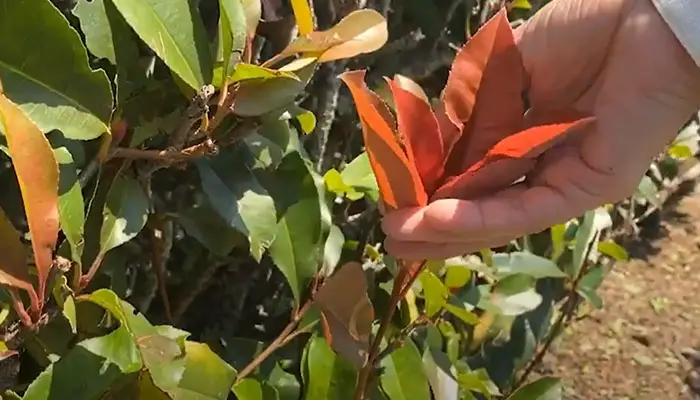Being red at first and then turning to green, red tip photinia is a great ornamental plant. Be it as a small tree or an ornamental shrub, photinia plants are always a slayer. You will surely love your photinia plants until you notice photinia leaf curl among them.
Well, it is a very common disease in red tip photinia plants. But unfortunately, it creates an unsightly view. So, it is obvious that you will be sick and worried thinking about why your photinia plant has curls.
Now there can be a lot of reasons for curly leaves of photinia. However, the main reason is fungal attacks. Phytophthora and other fungal diseases are generally responsible for this. The disease later leads to several other symptoms destroying the shrubs. Hence, prompt treatment becomes necessary. Pests and insects are also responsible.
Now that you are on this site, your photinia must be suffering from the same problem. Let us help you out with that by enlightening you on everything regarding the topic.
Symptoms of Photinia Leaf Curl

There are some distinct symptoms that will refer to the fact that your photinia plant has leaf curl disease. The signs or symptoms are,
- Bulging or waffling of the photinia leaves.
- Leaves turning in orange or yellowish in color. Later, becomes brown and then falls off one by one.
- Rolling inwards the leaf edges wilt or curl eventually.
- Gradually affects the branches of the photinia plants and lessens the bearings as well.
So, these are some main symptoms that indicate that your photinia plants are in danger and you have to save them.
Photinia Leaf Curl – Describing the Reasons

1. Fungal Disease
We have already mentioned that this photinia leaf problem is the result of fungal disease. Now to be specific, crown rot and root rot are the diseases of Phytophthora fungus. They also attack the photinia plant frequently.
The fungus leads the leaves to wilt, curl, and discolor. Eventually, the leaves drop off the plant. Not only the leaves, but the diseases affect the plant wood as well. Causing a slow growth rate, the fungus is also responsible for cankers of photinia.
Moreover, you can also find vertical streaks on the photinia plant wood. Meanwhile, you might find yourself discovering black or red sap coming from the affected wood part of the photinia plant. This is the stage when you realize your photinia plant might not live any longer.
2. Pest Attack
It is another reason why photinia in your garden is showing a leaf curl. Several pests and insects might attack the plant causing the leaves to curl eventually. The pests could be
White Flies
These pests are destructive to any ornamental plants. Even photinia plants are not spared from its attack. The pests not only attack the plants but also weaken the entire plant.
Moreover, sucking up the cell sap the pests make the leaves shrivel. Also, the pest leaves yellowish mottling over the plant leaves.
Again, this dandruff-like pest creates sooty mold fungus on the leaves causing the plant to die at a point.
Scale Insects
These insects are also responsible for causing photinia leaf curl. Curling up the leaf edges, the insects cause leaf fall. Eventually, they cause great damage to the plants.
Moreover, scale insects lead to the photinia stem after attacking the leaves. Hence, they also cause slow growth of the plant. Again, scale insects create a cluster of bumps on the leaf surface making it unsightly and unattractive.
Vine Weevil
Vine weevil attack on ornamental plants is very common. The pest mainly attacks the leaves and its root. Eating up the root causes wilting of the leaves as well.
However, the insect is highly destructive to the young leaves of photinia. On the other hand, vine weevil hardly attacks the photinia plant once it is established or matured.
Psyllids
This insect is not that common in photinia. Yet they can attack the plant causing curling of leaves. Sucking the cell sap from the leaves also causes discoloration and distortion of the entire plant.
When to treat Against Photinia Leaf Curl
Generally, the fungus that causes the disease of leaf curl hides in the form of spores during winter. The spores lay on the photinia plant bud or in its hollows. By the springs, the spores get formed.
Hence, you need to select the best time to kill the fungus. Like any other organism, the fungus also requires favorable environmental conditions to thrive. Once the temperatures get above 10 degrees Celsius or 50 degrees Fahrenheit, the fungus starts to release a large number of spores.
Again, warm and humid environmental conditions are favorable for the fungus to thrive well. Moist in the air help develop the fungus. Therefore, you should apply treatment before this period comes.
That means the beginning of spring or the end of winter is the most suitable time to deal with the fungus that is causing photinia leaf curl. However, to get the best result, you can apply the treatment in the fall. It is suitable because, during this period, the leaves are already fallen off.
Photinia Leaf curl – Treatment
The treatment of this problem may vary depending on the season. Like,
During Fall
During fall when the photinia plant leaves curl and has fallen, you need to adopt some treatment such as
- Pick up the fallen leaves and burn them away from the garden. It will not allow the disease to overwinter throughout the entire garden.
- Cleaning off the debris from the photinia garden, apply the Bordeaux mixture all over the plants. Spraying of Bordeaux mixture will keep the leaves of photinia from curling in spring.
During Spring
- Again, apply the Bordeaux mixture in spring as well. Spray over the leaves on a regular basis especially from February to March. In February the temperatures rise above 10 degrees Celsius or about 50 degrees Fahrenheit.
- To get the best result, spray the mixture every fortnight. However, before applying make sure to follow the instructions written on its packet.
- The third application of the Bordeaux mixture should be done when the photinia shows its first buds and burst.
Other Treatments You May Apply
- Cut off the branches of the photinia plants that are also affected and burn them away.
- Replace the soil of the photinia plant in your garden with fresh soil to reduce the fungal attack.
- Stop watering the exposed root of your photinia plant to stop the spreading of fungal attacks.
- If the fungal attack is severe, then use a commercial fungicide. But definitely be sure of the doses it says in its instructions. (our pick:Bonide 811 Copper Fungicide)
- To deal with the pests and insects, scrape off the bumps from the leaf surface of photinia.
- You can also use rubbing alcohol to remove several destructive insects and pests. Take some cotton and dip it into the alcohol. Then apply it over the leaves where the insects have created their reign.
- For severe attacks, you can buy insecticidal soap. Spray the soap over the photinia leaves to protect the plant. (our pick: Safer Brand 5110-6 Insect Killing Soap)
- For natural reduction, you can invite some beneficial insects or birds to eat up the pests. The ladybird beetle, grasshopper, and dragonflies are such examples.
- Again, if nothing works out then commercial pesticides [our pick] surely would. Just follow the instructions before getting started with the chemicals.
Prevention of Photinia Leaf Curl Diseases
Surely, prevention is the key to not having photinia with leaf curl. So, how can you prevent it? Let’s see.
Ensure Suitable Light and Temperature
This is the first thing to do to protect your plant from any unwanted situation. Photinia is an evergreen plant that loves to be exposed to full sun for at least about 5 to 6 hours. however, the plant also thrives in partial shade.
Nonetheless, if the area where you are going to plant your photinia plant is relatively cold, then try to plant it somewhere it will get full sunlight.
Fulfill Soil Requirement
The soil has to be well-drained where you will plant the photinia. Otherwise, it will cause root rot and other fungal diseases. Consequently, leaf curl will also take place. however, to amend the soil of your garden, you can use 50% compost to the garden soil before planting photinia.
Feed and Water
Feeding and watering the plant properly on a regular basis will protect the plant leaves from wilting and curling. However, when it rains, no need to water the plant.
Also, remember that photinia does not require watering frequently and deeply. Rather watering two and a half centimeters is just okay for the photinia plant.
Again, do not let the leaves of the photinia plant wet once they get matured. It might induce a fungal attack.
Fertilize the Plant
Generally, the photinia plant does not require to be fertilized if the soil contains enough nutrients. However, if the soil is poor in nutrient content, then you can use an organic slow-release fertilizer.
Optimum Requirement for Photinia Plant
| Soil pH | 6.0 to 7.5 (neutral or slightly acidic) |
| Water | 1/2 times a week |
| Temperature | 16 – 26 ℃ for thriving |
| Hardiness Zones | 7 to 9 USDA |
| Growth | 10-15 feet tall and wide |
FAQs
Why are the leaves on my photinia drooping?
There can be several reasons for your photinia plant leaves drooping. However, leaf curling is one of the reasons. The fungal attacks can wilt and curl the leaves causing their drooping as well.
How do you treat fungus on photinia?
If the attack goes severe, then you might have to take the help of chemical treatment. Many gardeners use propiconazole, myclobutanil, or chlorothalonil as effective fungicides. However, while applying the fungicide, you have to maintain time.
Applying the chemicals in the wrong season will act oppositely and might kill the entire plant as well.
How do you revive a red tip photinia?
Well, the best and ideal method of reviving your precious red tip photinia is its cut back at one time. The plant can tolerate about 6 inches of cutting back from the ground.
Final Words
Now that you know why your precious photinia has a leaf curl and its treatment, you should not worry anymore.
So, you can see that a little bit of care can save the plant from any diseases and pest attacks.
Thus, if our article was helpful enough then leave your feedback as well. Also, we will answer any of your queries.
- Propagating Plumeria Trees from Cuttings: Easy Steps - July 13, 2024
- How to Plant Plumeria Clippings? Easy Growth Guide - July 12, 2024
- How to Make a Plumeria Bloom? Secret Tips Revealed! - July 12, 2024

